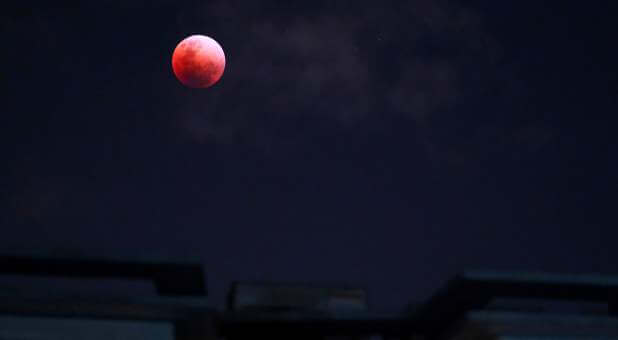For the first time since 1866, the earth will experience a “super blue blood moon eclipse,” a term that describes the combination of several amazing astronomical phenomena.
The term “blood moon” refers to a total lunar eclipse, during which the moon appears reddish-orange in color. The intriguing color is the result of the moon passing through the earth’s shadow and reflecting the sun’s “red” rays, earning the moniker “blood moon.”
Within the last few years, there have been four blood moons. Amazingly, each one fell on a major Jewish holiday: Passover and Sukkot. This close interval frequency is a very rare event. In fact, before the 20th century, there had been a lengthy period when there were no such eclipses.
But this year, for the first time in 150 years, the blood moon will coincide with an even rarer occurrence called a “blue moon,” which takes place every two and a half years. According to Space.com, the last time a total eclipse of a blue moon happened was way back on March 31, 1866, with the next blue moon eclipse not expected until Dec. 31, 2028.
On the evening of Jan. 31, people will be able to witness the alignment of three different types of moon cycles in one night! On that night, the blood moon will coincide with the blue moon and the “supermoon,” the latter of which describes a full moon reaching its closest point to the Earth in its orbit, when it appears about 14 percent bigger and brighter than it normally does.
What do the Torah and Jewish tradition have to say about blood moons? Well, for starters, the first blood moon eclipse coincided with the Jewish holiday of Passover, a pivotal event that commemorates the ancient Israelites’ Exodus from slavery in Egypt. We all know that first of the ten plagues was blood.
The 10th and final plague was death of the firstborn, after which the Egyptians literally kicked the Jews out of Egypt. Death is always associated with blood. Not only that, but the Israelites were commanded by God to paint lamb’s blood on their doorways so that the plague of the Firstborn would pass over their homes.
Blood Moons Coincide With Major Jewish Holidays
But there’s more. The last four blood moons occurred on major Jewish holidays. Passover 2014, followed by the holiday of Sukkot 2014, then again on Passover 2015 and then again on Sukkot 2015. This has happened only eight times in all of history.
And there’s even more! Major events of significance to the Jewish people happened on each of the last three recorded times that these rare blood moons occurred. They were events that changed the course and direction of Jewish history for all time.
A blood moon coincided with the Six-Day War in 1967, when Israel liberated Jerusalem; Jews were able to return to Jerusalem after 2000 years of exile. Sadly, Jewish blood was spilled during this war.
There was also a blood moon on the eve of Israel’s declaration of independence in 1948, following a bloody war that took place only a few years after the Holocaust, when six million Jews were murdered!
And finally, there was a blood moon in 1493, when Tomas de Torquemada, the first Spanish inquisitor, began slaughtering Jews.
Is the Blood Moon a Sign From Heaven?
Believers around the world of diverse faiths are attributing the blood-moon phenomenon to the teaching of the prophet Joel, who preached:
“Then I will work wonders in the heavens and the earth—blood and fire and columns of smoke. The sun will be turned to darkness, and the moon to blood, before the great and awe-inspiring day of the Lord comes” (Joel 2:30-31).
Inspired by the concluding words of Joel, some are suggesting that the blood moons are a sign from God that we are one step closer to the coming of the Messiah.
Is something wild or miraculous going to happen during the course of the upcoming series of blood moons? Nobody knows for sure. But perhaps the words of the Talmud can give us some insight on how we should relate to all possibilities and speculations:
“When the Jews perform the will of God, they need not worry about omens [or celestial phenomenon]. Thus says the Lord, ‘Do not be frightened by the signs of the heavens'” (Talmud Sukkah 29a).
This article originally appeared at unitedwithisrael.org.











































